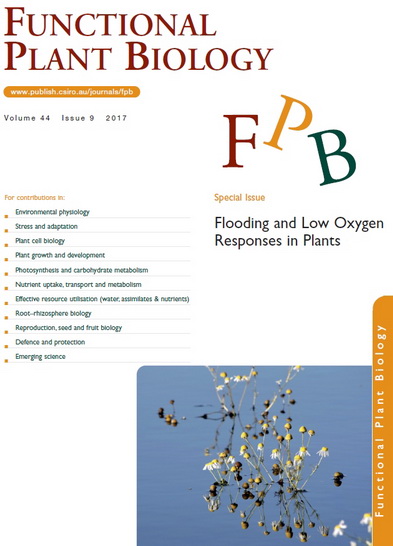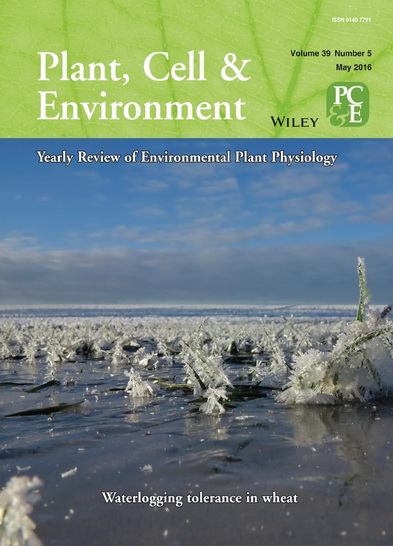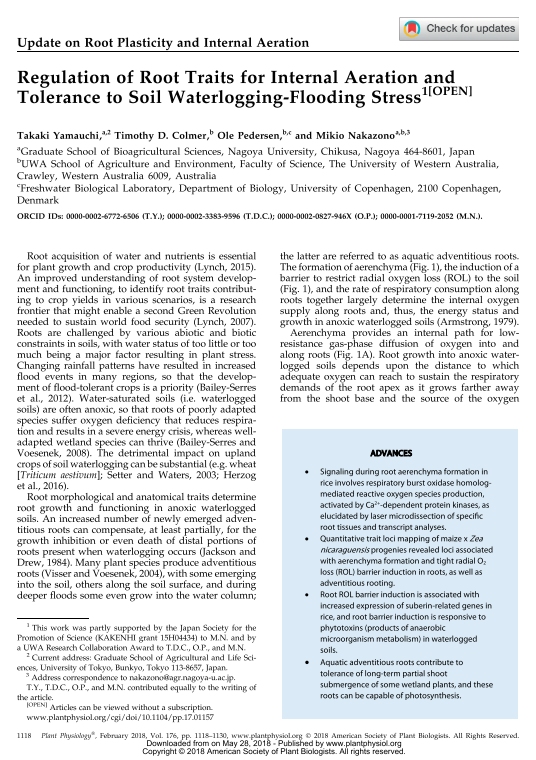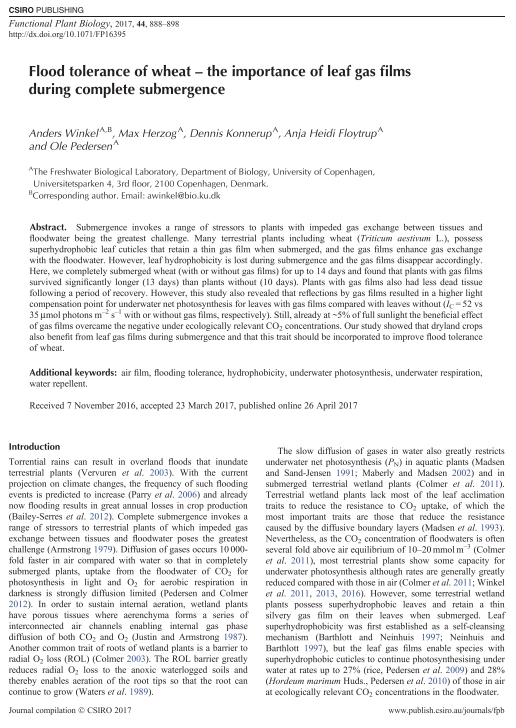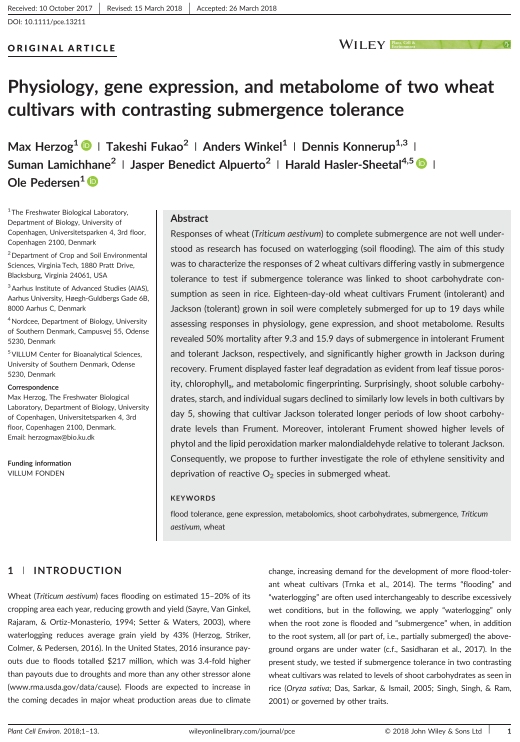Pedersen O, Perata P & Voesenek LACJ (2017) Flooding and low oxygen responses in plants Functional Plant Biology 44: iii-vi
The world is currently experiencing dramatic increases in flood events impacting on natural vegetation and crops. Flooding often results in low O2 status in root tissues during waterlogging, but sometimes also in shoot tissues when plants become completely submerged. Plants possess a suite of traits enabling tissue aeration and/or adjusted metabolism during hypoxia or even in the absence of O2. This special issue of Functional Plant Biology presents key papers for plant scientists on the quest to further address and improve flood tolerance of terrestrial plants. The papers address low O2 responses in roots, shoots or whole plants in controlled laboratory conditions or in the field situation using natural wetland plants as models as well as economically important crops, such as rice, wheat and barley. The studies advance our understanding of low O2 responses in plant tissues as caused by O2 shortage during flooding. However, in most instances, submergence not only leads to hypoxic or anoxic tissues, but inundation in water also results in accumulation of CO2 and the important plant hormone ethylene. Thus, carefully designed laboratory studies are often needed to unravel the mechanistic relationships between a combined decline in O2 followed by increases in CO2 and ethylene at tissue as well as on the cellular level.
Herzog M, Striker GG, Colmer TD & Pedersen O. (2016) Mechanisms of waterlogging tolerance in wheat – a review of root and shoot physiology. Plant, Cell & Environment 39: 1068-1086
We review the detrimental effects of waterlogging on physiology, growth and yield of wheat. We highlight traits contributing to waterlogging tolerance and genetic diversity in wheat. Death of seminal roots and restriction of adventitious root length due to O2 deficiency result in low root:shoot ratio. Genotypes differ in seminal root anoxia tolerance, but mechanisms remain to be established; ethanol production rates do not explain anoxia tolerance. Root tip survival is short-term, and thereafter, seminal root re-growth upon re-aeration is limited. Genotypes differ in adventitious root numbers and in aerenchyma formation within these roots, resulting in varying waterlogging tolerances. Root extension is restricted by capacity for internal O2 movement to the apex. Sub-optimal O2 restricts root N uptake and translocation to the shoots, with N deficiency causing reduced shoot growth and grain yield. Although photosynthesis declines, sugars typically accumulate in shoots of waterlogged plants. Mn or Fe toxicity might occur in shoots of wheat on strongly acidic soils, but probably not more widely. Future breeding for waterlogging tolerance should focus on root internal aeration and better N-use efficiency; exploiting the genetic diversity in wheat for these and other traits should enable improvement of waterlogging tolerance.
Yamauchi T, Colmer TD, Pedersen O & Nakazono M (2018) Regulation of root traits for internal aeration and tolerance to soil waterlogging-flooding stress. Plant Physiology 176: 1118-1130
Root acquisition of water and nutrients is essential for plant growth and crop productivity (Lynch, 2015). An improved understanding of root system development and functioning, to identify root traits contributing to crop yields in various scenarios, is a research frontier that might enable a second Green Revolution needed to sustain world food security (Lynch, 2007). Roots are challenged by various abiotic and biotic constraints in soils, with water status of too little or too much being a major factor resulting in plant stress. Changing rainfall patterns have resulted in increased flood events in many regions, so that the development of flood-tolerant crops is a priority (Bailey-Serres et al., 2012). Water-saturated soils (i.e. waterlogged soils) are often anoxic, so that roots of poorly adapted species suffer oxygen deficiency that reduces respiration and results in a severe energy crisis, whereas welladapted wetland species can thrive (Bailey-Serres and Voesenek, 2008). The detrimental impact on upland crops of soil waterlogging can be substantial (e.g. wheat [Triticum aestivum]; Setter and Waters, 2003; Herzog et al., 2016).
Submergence invokes a range of stressors to plants with impeded gas exchange between tissues and floodwater being the greatest challenge. Many terrestrial plants including wheat (Triticum aestivum L.), possess superhydrophobic leaf cuticles that retain a thin gas film when submerged, and the gas films enhance gas exchange with the floodwater. However, leaf hydrophobicity is lost during submergence and the gas films disappear accordingly. Here, we completely submerged wheat (with or without gas films) for up to 14 days and found that plants with gas films survived significantly longer (13 days) than plants without (10 days). Plants with gas films also had less dead tissue following a period of recovery. However, this study also revealed that reflections by gas films resulted in a higher light compensation point for underwater net photosynthesis for leaves with gas films compared with leaves without (IC=52 vs 35 mmol photons m–2 s–1 with or without gas films, respectively). Still, already at ~5% offull sunlight the beneficial effect of gas films overcame the negative under ecologically relevant CO2 concentrations. Our study showed that dryland crops also benefit from leaf gas films during submergence and that this trait should be incorporated to improve flood tolerance of wheat.
Flooding offields after sudden rainfall events can result in crops being completely submerged. Some terrestrial plants, including wheat (Triticum aestivum L.), possess superhydrophobic leaf surfaces that retain a thin gas film when submerged, and the gas films enhance gas exchange with the floodwater. However, the leaves lose their hydrophobicity during submergence, and the gas films subsequently disappear. We tested gas film retention time of 14 different wheat cultivars and found that wheat could retain the gas films for a minimum of2 days, whereas the wild wetland grass Glyceria fluitans (L.) R.Br. had thicker gas films and could retain its gas films for a minimum of4 days. Scanning electron microscopy showed that the wheat cultivars and G. fluitans possessed high densities of epicuticular wax platelets, which could explain their superhydrophobicity. However, G. fluitans also had papillae that contributed to higher hydrophobicity during the initial submergence and could explain why G. fluitans retained gas films for a longer period oftime. The loss ofgas films was associated with the leaves being covered by an unidentified substance. We suggest that leafgas film is a relevant trait to use as a selection criterion to improve the flood tolerance of crops that become temporarily submerged.
Responses of wheat (Triticum aestivum) to complete submergence are not well understood as research has focused on waterlogging (soil flooding). The aim of this study was to characterize the responses of 2 wheat cultivars differing vastly in submergence tolerance to test if submergence tolerance was linked to shoot carbohydrate consumption as seen in rice. Eighteen‐day‐old wheat cultivars Frument (intolerant) and Jackson (tolerant) grown in soil were completely submerged for up to 19 days while assessing responses in physiology, gene expression, and shoot metabolome. Results revealed 50% mortality after 9.3 and 15.9 days of submergence in intolerant Frument and tolerant Jackson, respectively, and significantly higher growth in Jackson during recovery. Frument displayed faster leaf degradation as evident from leaf tissue porosity, chlorophylla, and metabolomic fingerprinting. Surprisingly, shoot soluble carbohydrates, starch, and individual sugars declined to similarly low levels in both cultivars by day 5, showing that cultivar Jackson tolerated longer periods of low shoot carbohydrate levels than Frument. Moreover, intolerant Frument showed higher levels of phytol and the lipid peroxidation marker malondialdehyde relative to tolerant Jackson. Consequently, we propose to further investigate the role of ethylene sensitivity and deprivation of reactive O2 species in submerged wheat.

